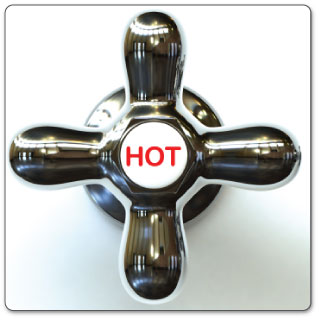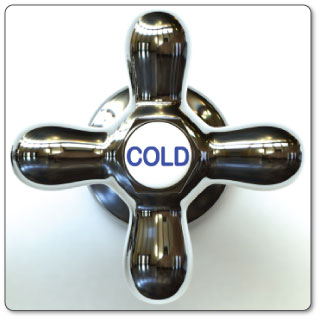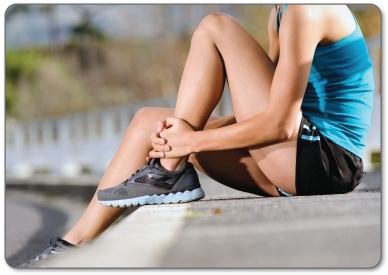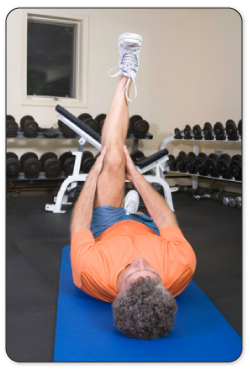When dealing with hip pain it's hard to know what treatment will work best for you. You might be wondering if ice and heat will work for you. Or maybe even which will work better - ice OR heat.
Icing and heating are 2 of the most natural treatment options available. Compared to medications, surgery and other treatment methods - icing and heating have been around for centuries and have always been used for hip injury healing as a means to soothe and heal.

We understand that it can get pretty confusing to figure out what conservative treatment method will work best with all of the treatment options available to you today. To get started, you should think about the benefits you'll get from using these therapies.
Ice and heat are the best treatment combination for you if:
Combining cold and warmth is a simple yet effective way to get immediate pain relief and promote long-term healing. In your lifetime you've probably had your mom, family doctor, nurse, surgeon or physical therapist tell you to use ice right after you're injured and something warm from time to time once the swelling's gone down. It's a simple yet very effective way to relieve pain and promote healing in your hip or lower back.
Hip injuries can happen to anyone, and right now there are thousands of doctors and physical therapists dealing with patients that require a solution to treat their hip injury fast and heal it (where possible).
If you want to be proactive about properly dealing with your bad hip, speak to your doctor about adding conservative temperature treatments to your recovery with MendMyHip's system using a Cold Compress or Ice Pack and Circulation Boost with a Back-Hip TShellz Wrap.
Your doctor knows that the sooner cold is applied, the quicker you can reduce inflammation and achieve real pain relief. This will help reduce the chance of a much longer lasting chronic injury. Heat and inflammation are a bad mix and should not be used together. Heat is good at the spa - it will help your body relax, but when it comes to an injury it is not a good idea (unless your physician specifically recommends otherwise).
A Cold Compress or Ice Pack work best to relieve pain, swelling and inflammation for new injuries, re-injury and during immediate post surgery recovery. A Cold Compress or Ice Pack should also be used during the first 24 - 72 hours of treatment, combined with resting your injury. Generally speaking, cold is recommended:
You haven't felt any pain in the area for the last week now, so you decide to head out for a 10 minute walk to get some fresh air. You realize near the end of the walk that the familiar pain is back and you are limping.
Use COLD on your hip to stop further damage to the micro tearing in your hip muscle and help ease the inflammation and pain.
Before getting active next time, do light stretches and apply a Back/Hip TShellz Wrap® treatment to the affected area 30 minutes to 1 hour before undergoing the strenuous activity. It will help limber up the area temporarily and lower the risk of re-straining the injury during this period.
You're not sure if you have an injury, but this pain seems to come and go only when you do a lot of walking, exercising or any twisting / pivoting on your leg. When you feel the sharp pain, the pain will continue to radiate in your groin for a few hours after and your leg feels weak.
Go See You Doctor to Get a Proper Diagnosis. Use a Cold Compress or Ice Pack as needed to reduce the radiating pain and any potential inflammation. If you feel like the area is tightening up, use the TShellz Wrap® treatment when getting up in the morning or before undertaking activity.
TShellz Wrap® treatments work best to increase blood flow circulation and relieve pain for older (chronic) injuries, re-injuries (after swelling has been reduced) and during long-term post surgery recovery.
TShellz Wrap® should not be used directly after an injury, as you must wait for swelling to drop. TShellz Wrap® treatments should not be started for a least 2 weeks after surgery because inflammation levels will be very high as the healing process starts over again. Any use of a TShellz Wrap® should also be combined with gradual movement to stretch out your hips and increase range of motion.
If you have a chronic hip injury that keeps getting re-injured or muscle spasms in the lower back, glutes, hips, abs, or thighs you should use a Back-Hip TShellz Wrap before activity to loosen up soft tissue (making it more flexible). This treatment is shown to increase the elasticity (flexibility) of the soft tissue in and around the treatment area, making it more pliable for activity and less likely to re-injure.
Sometimes we feel pain while doing a certain activity - should you still use a TShellz Wrap®? Using a TShellz Wrap in the morning before you start your day or before activity can help to boost blood-flow and reduce risk of further strain or injury. Use cold part-way through your day after you have been active so you can decrease pain and inflammation from the flare up.
Using a Back-Hip TShellz Wrap® is a good long-term plan because it will help stimulate blood flow (vasodilation) and can also be used on a preventive basis to relax constricted soft tissue (increased elongation & flexibility of muscles, ligaments and tendons). The use of a TShellz Wrap® indirectly enhances the local blood circulatory system, increasing the flow of nutrients your soft tissue needs to heal - oxygen, nutrients, anti-bodies and energy.
Our high quality wraps are registered with the FDA as medical devices which meet high manufacturing standards.
With regular use of the Back/Hip TShellz Wrap:

The most common soft tissue hip injuries are debilitating. At a minimum, they will impede your ability to extend and contract your hip joint. Being unable to move your legs in these ways will majorly interfere with everyday tasks like getting dressed, driving, working or reaching for anything.
When it comes to using ice and heat for treating a bad hip, it's important to keep in mind that both ice AND heat are very effective natural ways to relieve pain and heal. Most people will think one is better over the other from their own experience or what a doctor / physical therapist has previously told them specific to a previous treatment plan.
The only difference between using ice and heat is that 1 is better for you at a specific time in your healing cycle. Ice is used first, right when you get your injury, to decrease pain / swelling and inflammation. Once swelling has reduced, we then focus on heat based treatments to increase blood flow circulation in the area to stimulate the body's healing response.
Each temperature therapy has its own unique benefits for the hip (or any soft tissue really), and when used together, they provide a powerful advantage to long-term soft tissue health. You may already know that ice or heat feels better on your hip, and this could influence your decision too.
The bottom line is that ice and heat are exceptional, natural pain relievers and healers for soft tissue injuries. When we say soft tissue, we are talking about muscles, tendons, ligaments, cartilage and bursas. There are cases where some hip injuries will respond better to 1 temperature over the other. We want to help clear up the confusion so you know which is better (icy cold or gentle heat) and how to get the most from your treatment at home.

COLD (ice) is used to treat injuries or conditions that are red, hot, inflamed, swollen and suffering from tissue damage (a tear or recovering from surgery). Cold therapy is a natural / organic pain reliever that numbs pain right at the source of your injury. While doing this, the cold also stops cellular break-down and reduces the amount of scar tissue forming (this is very important after surgery).
When cold is applied to a hip injury, soft tissue in the hip will constrict and squeeze on the blood vessels to slow down your blood flow. This in turn clamps down on the amount of fluid leaking into your injured tissue, decreasing swelling. This is why cold is used immediately to treat acute (recent) injuries or re-injuries - basically, newly damaged soft tissue. The cold slows down your body to reduce the amount of damage happening to soft tissue and decrease the swelling. This cold also has a nice side benefit of numbing nerves in and around your hip, further decreasing your pain.
In the medical world this is something called 'Vasoconstriction'.
Cold compression works best to relieve pain, swelling and inflammation for new injuries, re-injury and during immediate post surgery recovery. Cold therapy should also be used during the first 24 - 72 hours of treatment, combined with resting your injury.
If you've been suffering for some time with a chronic hip injury you should only use cold after activity causes you more pain or triggers more inflammatory response symptoms (red, hot, inflamed, swollen). This would be when your hip, outer thigh or lower back starts to hurt at the end of the day after you've been on your feet throughout the day. When used at this time cold compression becomes a natural / organic pain reliever, targeting the localized site where you feel the pain.
Sometimes we feel pain while doing a certain activity - should you still use cold? Too much cold therapy can reduce your ability to heal correctly, because cold is a short term pain reliever, not a deep tissue healer.
This is important because once blood vessels are blocked or damaged, they can no longer carry oxygenated blood through the tissue and tissue begin to break-down. Without cold therapy, tissue damage and break-down continue as they cannot get the oxygen they need to survive. By limiting the amount of damage done to your hip, you also limit the amount of healing that needs to occur. This is an important step to heal hip joint injuries faster and with less pain!
Applying cold can restrict blood flow and stiffen / tighten soft tissue. Cold is NOT a good treatment method for soft tissue tears or strains when the tissue is already tight and constricted, because the cold will just stiffen the tissue further. Instead, use a treatment option that will increase blood flow, like the Back/Hip TShellz Wrap® to relieve tightened and constricted muscles Circulatory Boost used at this time will help relax / elongate soft tissue, making it much more pliable for activity.
HEAT (warmth) is used after you've reduced your swelling / inflammation and the sharp pain is less intense (you have more of a dull / nagging ache and soft tissue tightness in your hip). Warming up tissue is a natural way to encourage healing of muscles, tendons and ligaments. It's the blood in your body that will bring oxygen, nutrients and water (basically energy) to your injured hip to help with healing.
When heat is applied to the hip, veins and blood vessels will start to get bigger (expand) to allow more blood flow through to your damaged or torn soft tissue. This in turn relaxes your hip, making the tissue more flexible and elastic. This is why heat is used on older (chronic) injuries, to loosen tissue and bring in the blood flow needed for soft tissue to repair. Your body will begin to heal itself after it is injured - increasing your blood flow with heat will, in most cases, speed up this natural process - often surprisingly well.
Doctors usually call this process 'Vasodilation'.
When we injure ourselves, we start healing right away. The body will naturally raise the temperature at the site of the injury resulting in the inflammatory response (redness, heat sensation, inflammation and swelling). This 'fake fever' leaks blood flow to the area to cool it down and start the healing process.
Adding 'heat' to your hip when it's already inflamed and tender may make your body think there's a new threat to your tissue and increase the pain in order to get you to stop. For some people applying heat on inflamed / swollen tissue will cause the injury to swell-up even more (as much as 3 times larger than normal). You'll feel even more pain as the pressure builds in your hip.
Heat is NOT a good treatment method for inflamed soft tissue, new injuries (within the first 24 to 72 hours), right after surgery or right after a re-injury (over-use and/or sharp, throbbing pain). In these cases, heat should be applied later on in the healing cycle once swelling has calmed down substantially. In the meantime, use a Cold Compress or Ice Pack to decrease any inflammation induced pain.
The primary intent of a heat based application is to increase blood flow circulation and, as such, stimulate the body's recovery rate for older (chronic) or recent (acute) injuries, long-term post surgery recovery and more recently - for some regenerative therapies performed by doctors and pts. Warmer temperatures should be used approximately 3 to 5 days after you first have the injury or even later if the swelling has not reduced significantly. Heat should not be started for a least 2 weeks after surgery because inflammation levels will be very high as the healing process starts over again. Any use of heat should also be combined with gradual movement to stretch out your hip and increase range of motion.
If you have a chronic hip injury that keeps getting re-injured you should use heat before activity to loosen up your tissue (making it more flexible). When used at this time the warm temperatures naturally extend the elasticity (elastic-nature) of the joint, making it more movable / pliable for activity.
Sometimes we feel pain while doing a certain activity - should you still use heat? Using heat in the morning before you start your day or before activity can help to boost the healing process and reduce your risk of re-injury. Too much heat (especially when you suffer a set-back with swelling / inflammation) can make your inflammation worse. Cold treatments with a Cold Compress or Ice Pack should be used part-way through your day when you suffer from on-going pain and inflammation as a natural pain-reliever.
Using heat is a good long-term plan because it can be used on a preventive basis to relax constricted soft tissue. Heat will increase the volume of blood circulation, which in turn, brings all the components your body needs to heal more efficiently - oxygen, nutrients, anti-bodies and energy.
Click HERE to Go To Our Online Store We take all major credit cards and Paypal. If you are on your mobile phone, Click to Call Our Office (toll free continental NA).
For many people, the treatment doesn't just end with Heat and/or Cold applications. Stretching is plays an important part in hip soft tissue recovery - and it's the final step needed when healing your injury with conservative treatment methods.

You would be surprised by how many people there are that don't understand the importance of stretching a deep tissue hip injury. Before returning to full activity after a hip injury, physical therapists prescribe gentle stretching of the affected area... This is because stretching an important part in recovery from any soft tissue injury. Consistent stretching is one of few solutions available to break up scar tissue that forms on your hip as it heals.
Stretching with use of a Cold Compress or Ice Pack and TShellz Wrap® is even better!
We're going to let you in on a key piece of information... In every physical therapy appointment your physical therapist will use conservative treatments, massage, manual manipulation and/or stretching exercises to give you this Professional 3-Step Treatment Formula:
For this 1st step many physical therapists will use heat, manual manipulation, deep tissue massage, clinical ultrasound devices or a warm bath to warm up your hip. The goal during this first step is to increase healthy blood flow circulation and relax your affected hip.
'Warming up' your hip will increase the elastic-nature of your hip fibers making it much easier to stretch and when needed, hold the stretch. This will also extend the amount that you will be able to stretch your hip.
Use a TShellz Wrap® for 15 to 20 minutes at least half an hour before stretching your hip. A TShellz® Circulatory Boost Wrap is a therapy intended to increase the blood flow to the knee while warming up and relaxing soft tissue in the treatment area. This will make your hip fibers more elastic and pliable, allowing for more ease of movement when you're stretching and/or exercising.
Continued treatment with the T•Shellz Wrap will also deliver much-needed oxygen, nutrients and water (basically energy) to your hip. In most cases, this will boost your body's own natural healing ability and speed up your time for recovery.
The main goal of physical therapy is to exercise (stretch out) the affected hip to improve flexibility and range of motion. After the physical therapist has warmed up your hip, they'll get you to do a series of exercises that are focused on stretching out your hip.
This exercise may include heel slides that are focused on moving your how leg and hip (quadriceps, groin, hip, hamstring, calf and shin).
Sometimes cardiovascular exercise, like using a stationary bike or treadmill, will be recommended under the supervision of your physical therapist.
Why are hip injuries so hard to over come? In two words - scar tissue.

Soft tissue in the hip is meant to be tough yet flexible, ready to work and move extreme forces in everyday activities. Damaged tissue heal with scar tissue; little tiny band-aids that overlap each other on the tissue mending the injury. With added scar tissue your hip becomes rigid, less able to receive the full force of your movements. If you're suffering with scar tissue now, you may feel the effects with stiffness, tightness, weakness and tiredness in your hip.
Scar tissue can form fast to bring together the edges of a tendon, ligament of the tissue tear, but working fast doesn't mean that the job's done right. When scar tissue forms it doesn't come together as neatly as regular (healthy) tissue would. Scar tissue fibers will lay down over top of your tear in a cluttered, messy and jumbled up way.
Stretching helps to break up scar tissue, ultimately reducing its troublesome effects on your body.
Toward the end of your appointment your physical therapist may introduce cold compression, acupuncture, or TENS to relax your hip after the intense stretching and exercise.
It may seem hard to believe, but our TShellz Wraps® and accessory products will assist you in recovering from your injury by reducing your swelling and inflammation induced pain, maximizing localized blood flow, and increasing the flexibility / range of motion in the hip.
Here at MendMyHip we pride ourselves in helping you with your healing and recovery process. Everyone at MendMyHip has tested and used the products, finding solutions to conditions that do not fit into the norm. This dedication to our customers and our products goes hand-in-hand with our guarantees to you as a customer:
Product Advisors are available 9:00 am to 5:00 pm Eastern Standard Time Monday to Friday.
Living with pain is never easy and we encourage you to call us with any questions you have related to your knee injury. We will do our best to help.
Product Advisors are available 9:00 am to 5:00 pm Eastern Standard Time Monday to Friday.
I want to learn more about Hip Surgery & Post-Surgery Recovery
I want to learn more about Circulation Boost
I want to learn more about Ice & Heat: Which Is Better For The Hip?
I want to learn more about Trigger Points in the Hip
I want to learn more about Hip Surgery: Do I Need It?
During your recovery, you will probably have to modify and/or eliminate any activities that cause pain or discomfort at the location of your soft tissue injury until the pain and inflammation settle. The more diligent you are with your treatment and rehabilitation, the faster you will see successful results!
Please be aware that this information is neither intended nor implied to be a substitute for professional medical advice. CALL YOUR HEALTHCARE PROVIDER IMMEDIATELY IF YOU THINK YOU MAY HAVE A MEDICAL EMERGENCY. Always seek the advice of your physician or other qualified health provider before using any of our outstanding products to make sure they are right for you and your condition or if you have any questions regarding a medical condition. Always see your doctor for a proper diagnosis as there are often many injuries and conditions (some very serious) that could be the cause of your pain.
© 2025 In.Genu Design Group, Inc. Contact Us